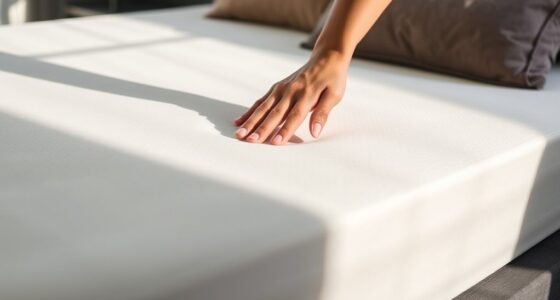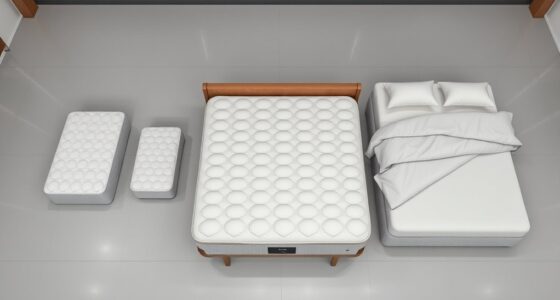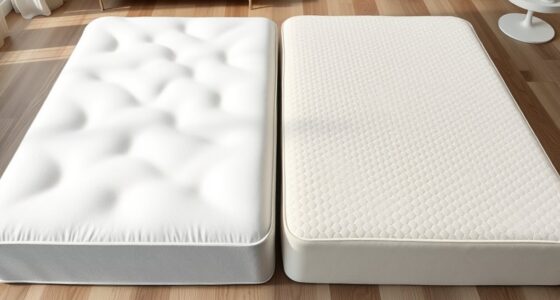Most experts recommend replacing your mattress every 7 to 10 years to maintain proper support and comfort. Signs like sagging, lumps, persistent aches, increased allergens, or visible wear mean it’s time for a change. Mattress age plays a big role in sleep quality, and regular maintenance can extend its lifespan. By staying attentive to signs of wear, you can ensure better sleep—and there’s more to learn about maintaining your mattress effectively.
Key Takeaways
- Most mattresses should be replaced every 7 to 10 years for optimal support and comfort.
- Signs of sagging, indentations, or discomfort indicate it’s time for a replacement.
- Regular wear and tear, including lumps or broken springs, suggest a mattress is nearing the end of its lifespan.
- Older mattresses can harbor allergens and dust, affecting sleep quality and health.
- Proper maintenance, like rotation and use of protectors, can extend mattress life but not beyond about a decade.
Signs That Your Mattress Needs Replacing

Your mattress can show signs it’s time for a replacement, even if you don’t notice them right away. Poor sleep hygiene often results from a mattress that no longer supports your body properly. Look for sagging or indentations, which indicate worn-out mattress materials that can lead to discomfort. If you wake up stiff or with aches, your mattress might have lost its firmness or support. Additionally, persistent allergies or difficulty sleeping could be signs of trapped dust and allergens in the mattress. Over time, mattress materials break down, reducing their effectiveness. Regularly inspecting your mattress for these signs helps ensure you maintain good sleep hygiene and avoid long-term health issues. Understanding mattress deterioration can help you recognize when it’s time to replace your mattress. Replacing your mattress when needed keeps your sleep quality high and supports overall well-being.
General Recommendations for Mattress Lifespan

Most mattresses are designed to last between seven and ten years, but their actual lifespan depends on factors like usage, maintenance, and quality. Advances in mattress innovation and sleep technology have extended some mattress lifespans, especially with materials like memory foam and hybrid designs that resist sagging. However, even high-quality mattresses eventually wear out and lose support. Regularly evaluating your mattress’s comfort and support can help determine if it’s nearing the end of its lifespan. If you notice persistent sagging, increased allergies, or discomfort despite proper care, it’s time to contemplate a replacement. Staying informed about the latest sleep technology can help you choose a more durable mattress, ensuring better sleep and longer-lasting comfort. Additionally, paying attention to mattress lifespan and signs of wear can help you plan for timely replacement to maintain optimal sleep quality.
Factors That Influence Mattress Durability

Several factors directly impact how long a mattress remains supportive and comfortable. Your sleep hygiene plays a key role—if you don’t keep your sleep environment clean and dry, mold, dust, and allergens can accelerate wear. Bedding materials also matter; softer, high-quality fabrics like memory foam or latex tend to retain their shape longer than cheaper alternatives. How often you rotate or flip your mattress can prevent sagging and uneven wear, extending its lifespan. Additionally, your weight and sleeping position influence durability; heavier individuals or those who sleep in one position exert more pressure, causing faster breakdown. Proper care, such as using a mattress protector and maintaining a consistent sleep routine, can help preserve your mattress’s durability and support over time. Regularly inspecting your mattress for signs of wear can also extend its lifespan, ensuring you get the most value out of your investment.
How to Assess the Condition of Your Mattress

Evaluating the condition of your mattress is essential to determine whether it still provides proper support and comfort. Start by checking its material composition—see if the foam, innerspring, or memory foam layers have worn out or sagged. Look for visible signs of wear, such as sagging, lumpy spots, or broken springs. Pay attention to how well your mattress accommodates mattress customization; if it no longer adapts to your body or feels uneven, it’s a sign it’s past its prime. Test for firmness and support by lying down and noticing any discomfort or pressure points. If you wake up with aches or if the mattress feels less supportive than before, it’s time to contemplate replacing it. Regular assessments help ensure your sleep remains comfortable and healthy. Additionally, consider the presence of mattress odors or signs of mold, which can indicate contamination and the need for replacement.
The Impact of Mattress Age on Sleep Quality

As your mattress ages, its ability to support restful sleep diminishes, often leading to discomfort and disrupted nights. An older mattress can cause sagging, loss of firmness, and uneven surfaces, which negatively impact your sleep hygiene. Poor sleep quality affects your overall health and daily productivity. Additionally, as the mattress deteriorates, it can trap dust, allergens, and moisture, worsening the bedroom environment. This buildup can lead to allergies or breathing issues, further disrupting sleep. Regular maintenance and replacement of your mattress ensure optimal sleep conditions and health benefits. Replacing your mattress at the right time helps maintain ideal sleep quality and promotes a healthier bedroom environment. Recognizing signs of age-related decline ensures you prioritize your sleep health and avoid the negative effects of sleeping on an outdated, worn-out mattress.
Differences in Replacement Timing for Various Mattress Types
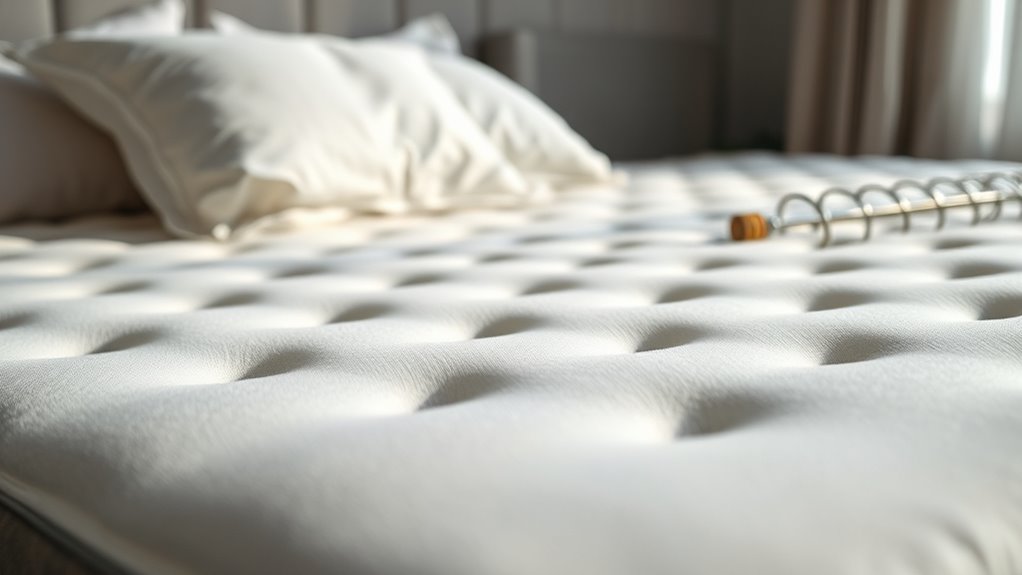
Different mattress types have varying lifespans, so knowing when to replace them depends on the material and construction. Foam mattresses typically last 6-8 years, thanks to foam durability, but signs of sagging indicate it’s time for a replacement. In contrast, innerspring or coil mattresses offer coil longevity of about 7-10 years, though they may develop squeaks or sagging sooner. Hybrid mattresses combine these elements and usually last around 8 years. Use the table below for a quick comparison:
| Mattress Type | Approximate Lifespan | Key Indicator for Replacement |
|---|---|---|
| Foam | 6-8 years | Sagging, loss of support |
| Innerspring/Coil | 7-10 years | Squeaks, sagging, reduced comfort |
| Hybrid | 8 years | Wear on foam or coils |
Being aware of material durability can help you plan timely replacements for ideal sleep.
When to Consider Upgrading Your Mattress

Knowing when to upgrade your mattress is essential for maintaining quality sleep and overall health. If your mattress materials have deteriorated, you might notice sagging, lumps, or worn-out areas that no longer support your body properly. Changes in your sleep environment, such as increased allergies or persistent discomfort, also signal it’s time for a new mattress. Additionally, if you wake up feeling tired or experience aches and pains regularly, your current mattress may be contributing to poor sleep quality. Over time, even the best mattress materials lose their resilience. Upgrading guarantees you restore comfort and support, creating a healthier sleep environment. Recognizing these signs helps you decide when it’s time to invest in a new mattress for better rest and well-being. Regularly assessing your mattress can help prevent sleep disturbances and ensure you maintain optimal sleep quality.
Tips for Extending Your Mattress’s Lifespan

To make your mattress last longer, start by rotating it regularly to prevent uneven wear. Using a mattress protector can shield against spills and dust, extending its comfort and durability. Also, guarantee your bed has proper support to maintain its shape and prevent sagging over time.
Regularly Rotate Mattress
Regularly rotating your mattress is a simple yet effective way to extend its lifespan. By flipping or rotating it every three to six months, you help distribute wear evenly across the mattress materials. This practice supports better sleep hygiene, as it prevents sagging and indentations that can disrupt your sleep comfort. Different mattress types respond uniquely to rotation; memory foam and latex mattresses benefit from regular flips, while pillow tops may only need rotation. Consistent rotation also maintains proper support, reducing pressure points and potential discomfort. Incorporating this habit into your routine ensures your mattress stays in good condition longer, ultimately saving you money and enhancing your sleep quality. Proper care, including rotation, is key to maximizing your mattress’s durability. Ignoring progress reviews can lead to unnoticed issues, so regularly assessing your mattress’s condition helps you catch problems early and make necessary adjustments.
Use Mattress Protectors
Using a mattress protector is one of the simplest ways to extend your mattress’s lifespan. It shields your memory foam mattress from spills, stains, and allergens that can cause deterioration over time. A high-quality protector also minimizes wear and tear, helping maintain its comfort and support. When choosing a protector, guarantee it’s compatible with your bed frame and fits snugly to prevent bunching. A waterproof cover prevents moisture from seeping in, which can lead to mold and mildew, especially in humid environments. Plus, a breathable protector helps regulate temperature and keeps your mattress fresh. Regularly washing the protector keeps it clean and prolongs its effectiveness. An additional benefit is that some mattress protectors come with extended warranty benefits, providing extra peace of mind. Investing in a good mattress protector is a cost-effective way to protect your mattress and extend its lifespan.
Maintain Proper Support
Maintaining proper support for your mattress is key to prolonging its lifespan. Make sure your bed frame or foundation provides even support to prevent sagging. For foam mattresses, check the foam density; higher-density foam resists sagging and maintains shape longer. If your mattress has springs, monitor spring tension regularly, as weakened springs lose support and cause indentations. Rotate your mattress every three to six months to distribute wear evenly, which helps prevent sagging and maintains proper support. Avoid jumping or putting excessive weight on the mattress, which can damage foam layers and spring systems. Using a supportive foundation and regularly inspecting foam density and spring tension keeps your mattress in shape, helping it serve you better for years to come. Self Watering Plant Pots can also help maintain proper moisture levels, indirectly supporting your mattress’s longevity by reducing the need for excessive cleaning or moisture-related issues around your sleeping area.
Recognizing Wear and Tear Indicators
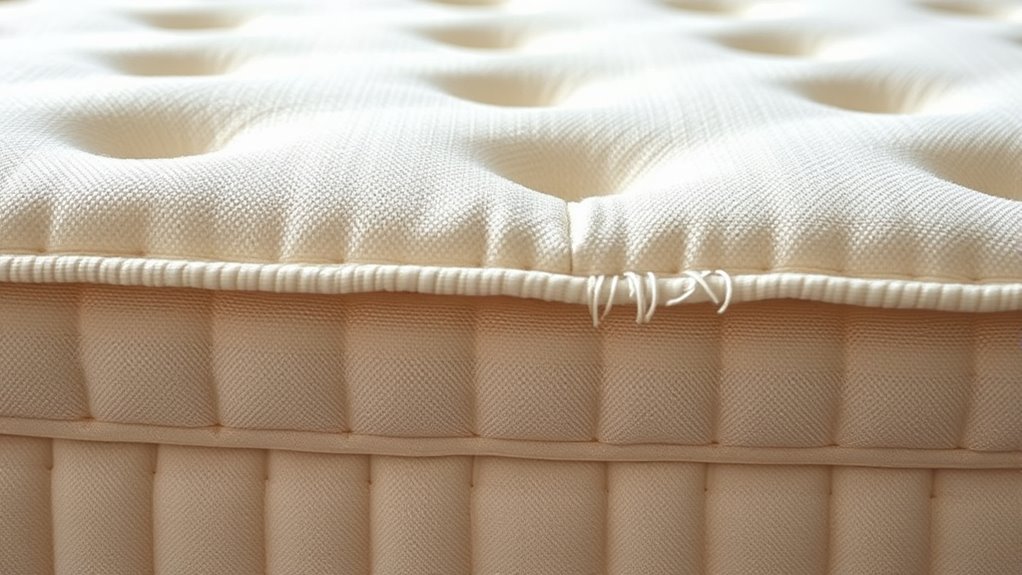
Over time, your mattress will show signs of wear that can impact your sleep quality. Look for uneven spring tension, which causes sagging or dips, making your sleep uncomfortable. Fabric fraying along the edges or surface indicates deterioration and reduces mattress integrity.
| Wear Indicator | What to Watch For |
|---|---|
| Spring Tension | Sagging, dips, or uneven support |
| Fabric Fraying | Visible tears, worn edges, or loose threads |
| Lumps or Bumps | Lumpy surface that disrupts comfort |
| Increased Noise | Squeaking or creaking when moving |
| Persistent Allergies | Dust or allergens trapped in worn material |
Recognizing these signs early helps you determine if it’s time to replace your mattress before sleep quality declines further.
The Role of Mattress Maintenance and Care

Proper mattress maintenance can considerably extend its lifespan and preserve sleep quality. Regularly rotating and flipping your mattress helps prevent uneven wear, ensuring it remains supportive. To keep your sleeping environment healthy, focus on pest prevention by keeping bedding clean and vacuuming your mattress regularly. This also aids in allergen control, reducing dust mites and allergens that can accumulate over time. Using a mattress protector can further shield against spills, stains, and allergens. Keep your bedroom well-ventilated to reduce moisture, which discourages mold and pest issues. Addressing these maintenance tasks not only prolongs your mattress’s life but also creates a healthier sleep space. Proper maintenance is essential for maximizing your mattress’s durability and comfort. Consistent care guarantees you get the most comfort and support from your mattress, delaying the need for replacement.
Frequently Asked Questions
Can a New Mattress Improve My Sleep Quality Immediately?
A new mattress can definitely boost your sleep quality right away. Modern mattress materials often provide better support and comfort, reducing aches and tossing. When you switch to a mattress suited to your needs, you’ll likely notice improved sleep, feeling more refreshed each morning. Keep in mind, the right mattress tailored to your preferences and sleep habits makes a significant difference in how restful your sleep becomes immediately after replacing it.
Is It Better to Buy a Mattress With a Longer Warranty?
When choosing a mattress, longer warranty coverage often indicates better quality and durability, giving you peace of mind. It can also help you decide on replacement timing, as a longer warranty suggests the mattress will last longer before needing replacement. However, don’t rely solely on warranty length—consider comfort, support, and how well the mattress meets your needs. Ultimately, select a mattress with a warranty that aligns with your expectations and usage.
How Do Mattress Materials Affect Longevity?
The materials used in your mattress directly impact its durability and material lifespan. For example, memory foam tends to last 7-10 years, while latex can endure up to 15 years or more. Hybrid and innerspring mattresses may have varying lifespans depending on quality. You should choose high-quality materials to guarantee your mattress remains supportive and comfortable longer, reducing the frequency of replacements and maintaining better sleep quality over time.
Are There Specific Brands Known for Longer-Lasting Mattresses?
When choosing a mattress, you’ll find that brand reputation and material durability matter. Brands like Tempur-Pedic, Sealy, and Casper are known for longer-lasting mattresses due to high-quality materials and solid construction. You should look for reviews highlighting durability, and consider brands with good warranties, as they often indicate confidence in their product’s longevity. Investing in a reputable brand guarantees your mattress remains supportive and comfortable for years.
What Are Eco-Friendly Options for Replacing My Mattress?
Imagine replacing your mattress with one made from sustainable materials, like organic latex or recycled steel springs. Eco-friendly options include mattresses certified by organizations like GOTS or CertiPUR-US, ensuring they meet strict environmental standards. These choices reduce your carbon footprint and support greener living. When selecting a replacement, look for eco-friendly certifications and opt for materials that promote durability and health, making your sleep environment both sustainable and comfortable.
Conclusion
Remember, your mattress is the foundation of your nightly escape to dreamland. Don’t wait until sleep becomes a nightmare—trust your instincts and check for signs of wear. After all, a good mattress isn’t just about comfort; it’s about investing in your health and happiness. Keep an eye on its age and condition, and treat it well. Because in the end, a well-loved mattress is your ticket to restful, rejuvenating sleep.



